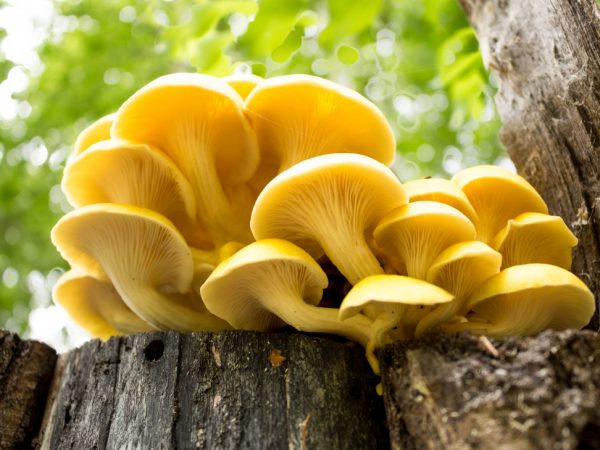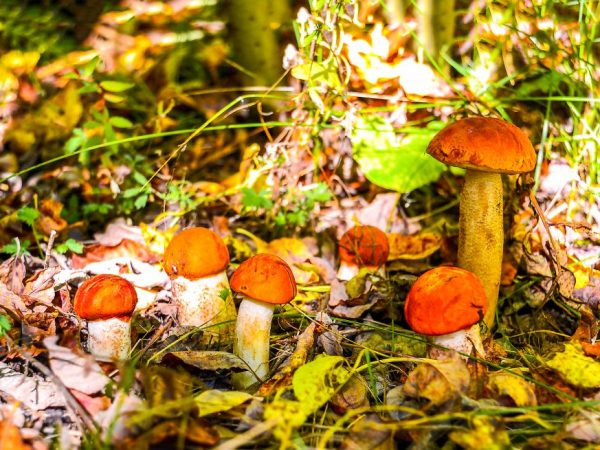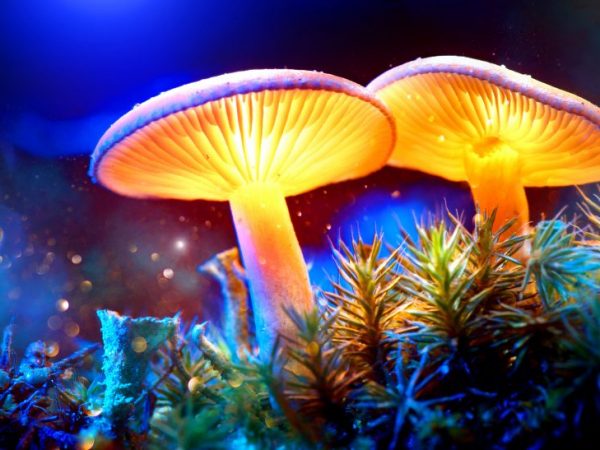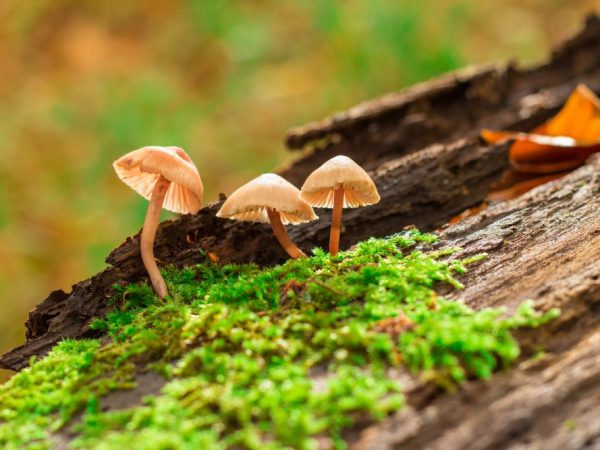Description of the kingdom of mushrooms
The kingdom of mushrooms was separated into a separate taxonomic unit in the 70s of the last century. These are eukaryotes that combine some of the traits of plants and animals. They are distributed all over the world, lead a saprophytic, parasitic or symbiotic lifestyle. Some are used to make medicines.

Description of the kingdom of mushrooms
general description
The first mushrooms appeared millions of years ago and are considered the oldest organisms on Earth. Species characterization includes some common characteristics of plants and animals. For a long time they were attributed to the flora, but now they have been allocated to a separate kingdom.
Common traits with plants:
- The absorption of nutrients by the osmotic pathway (in the majority).
- Fixed (attached) lifestyle on the substrate.
- Reproduction by spores.
- Growth without restrictions in time and space.
- The presence of a cell wall.
- The presence of vacuoles.
Common traits with animals:
- Heterotrophic way of eating.
- One of the elements of the cell wall is chitin, not cellulose.
- The end product of the exchange of nitrogenous compounds is urea.
- Energy storage substance - glycogen.
- Synthesis of digestive enzymes.
- The ability to synthesize melanin by living cells.
The study of this kingdom is engaged in science, which is called mycology. It includes real mushrooms and mushroom-like organisms, which, for a number of reasons, do not fit into the general description. In total, there are 100-250 oo0 varieties, observations are constantly being made and new ones are being discovered, the taxonomic table is regularly updated. They are included in thousands of genera and hundreds of families.
Mushrooms inhabit all climatic zones and major ecological niches, including hot springs and frozen ground. They are found in forests and forest belts, fields and reservoirs. Many live on the surface of living organisms - animals and plants, inhabit the digestive tract and internal organs of mammals and humans. These organisms come in different sizes. For example, the mycelium of forest species reaches tens of kilometers in area, and microscopic yeasts are visible only under a microscope.
The structure and genetics of fungi
The main vegetative organ of the fungus is the mycelium or mycelium, which looks like a thin web. It consists of numerous hyphae and is densely immersed in the habitat (substrate). Through the walls of the mycelium, nutrients are absorbed, enzymes and metabolic products are released, respiration is carried out, it firmly fixes the fruit body in soil and other substrates. In unicellular microorganisms, the mycelium is a multinucleated syncytium with one cell membrane. In higher fungi, it consists of many cells arranged in a row.
Mushroom hyphae grow only at the apical (end) point, which is why the growth is called apical. For reproduction in some multicellular species, fruiting bodies are formed.They consist of tightly intertwined mycelium filaments that rise above the substrate. Typical fruiting bodies, with a stalk and a pigmented cap, form forest mushrooms. Some mold species have similar formations, although the stem and cap are not so pronounced here. This allows mature spores to spread over long distances.
Cellular structure
The cytological structure of fungi differs from that of animals and plants. They are always multinucleated, while the chromosome set in different nuclei of one cell is often different. The cell walls are composed of lipids, phospholipids, proteins, and complex polysaccharides. They have holes through which not only nutrients pass, but nuclei, plasmids and other parts of cells.
In the cytoplasm, in addition to the nucleus, there are vacuoles with a supply of nutrients (lipids, amino acids, glycogen, polyunsaturated fatty acids). The walls of mitochondria (energy stations of the cell that synthesize ATP) have a plastic structure. Chitin filaments, like in arthropods, act as a skeleton supporting the structure of the cell. From above, the cytoplasmic membrane is surrounded by a wall of polysaccharides, like in plants.
Features of genetics

The genetics of fungi began to be studied recently.
Fungal genetics have been described in recent decades. The number of chromosomes varies in different species from 2 to 25 pieces, on average, 10-12 pieces. The amount of genetic material is less than that of plants and even some bacteria. A characteristic feature of fungi is the presence of short B chromosomes that do not carry the information necessary for the vital activity of the organism. This is a "spare" material that is embedded at certain points in the main chromosomes, improving the body's adaptability to new conditions (increases the virulence (ability to infect) parasitic strains, resistance to drought, new chemical composition of the substrate, etc.).
Part of the genetic material (DNA strands) is located in plasmids - specific cytoplasmic formations. They are characteristic of fungi and bacteria and are practically not found in representatives of other kingdoms. Also, DNA is found in mitochondria. In many specimens, foreign genetic material introduced by specific viruses is found. It plays both a positive and a negative role. Disease-causing viruses of fungi are capable of destroying entire populations.
Mushroom nutrition
Heterotrophs are fungi adapted to take nutrients from the external environment by osmosis through the cell wall. They are not able to produce organic matter on their own using photosynthesis, like grass. For this, the main thing is to have chlorophyll, which is absent in fungal cells.
Only simple substances penetrate through the cell wall. Therefore, external digestion is characteristic of most mushrooms. In the mycelium, enzymes are synthesized and released into the external environment - lipases (break down fats), proteases (break down proteins), carbohydrases (break down complex polysaccharides, i.e. based on a carbon chain).
There are species that have only one type of enzyme, therefore they settle only on a certain substrate. Unicellular yeast does not have enzymes; it can live only in an environment rich in simple carbohydrates (glucose, sucrose).
According to the type of nutrition, all mushrooms are divided into:
- saprophytes;
- parasites;
- symbionts.
Saprophytes: this is the name of the most numerous group inhabiting the soil, water space, inanimate objects. They receive nutrients from the external environment (decomposing residues), synthesize all types of enzymes. Complex initial organic substances are decomposed by saprophytic fungi into simpler components, which they then feed on.
Parasites: live off other organisms (plants, animals), gradually depleting and eventually killing them. Most often they settle on the surface of leaves, tree bark, skin of animals and people.But they can also penetrate the internal organs.
Symbiosis: a special type of cohabitation of living organisms, when they bring each other mutual benefit. Many fungi entwine tree roots with their mycelium, hyphae grow into cells. They supply the plant with mineral elements and water, from it they receive organic matter, which is used for food. A special type of symbiosis is lichens, for example, reindeer lichen. In them, the fungus is responsible for the supply of minerals, and the alga is responsible for photosynthesis. There are fungi that live in the digestive tract of animals and are involved in digestion.
Mushroom propagation

Mushrooms have a complex reproduction process
Mushroom propagation takes place in different ways:
- vegetative;
- sexual;
- asexual.
Mushrooms of different species at certain periods of life choose one or another method of reproduction, depending on the environmental conditions.
Vegetative propagation
Vegetative reproduction is the simplest, it is possessed by protozoa, some plants. The essence of the method is that a part of the organ is separated and gives life to a new organism. The fungus reproduces vegetatively:
- By separating part of the mycelium.
- Arthrospores (oidia), formed after the decomposition of the mycelium into separate particles.
- By the budding of hyphae (typical for yeast, ascospores of higher varieties).
Asexual reproduction
Asexual reproduction is carried out with the help of spores, but the exchange of genetic material does not occur, in contrast to the sexual method. There are such types of spores during asexual reproduction:
- Endogenous: sporangia develops inside the cells, typical of the lower representatives of the kingdom.
- Exogenous (conidia): formed on the tops of special mycelium hyphae - conidiophores, which grow vertically, can be simple or branched. Spores are covered with a strong shell and are carried by wind, water, and animals.
- Zoospores: a special type of motile spores with small flagella, characteristic of many lower fungi.
Sexual reproduction
Sexual reproduction is a complex process that has its own characteristics and differs in different categories of mushrooms.
Sexual reproduction occurs after cell division by meiosis. Only half of the maternal chromosomes remain in the daughter structures. This ensures the exchange of genetic material and the variability of the species. For sexual reproduction, fungi have the following mechanisms:
- Isogamy or fusion of two cells of the same size and structure.
- Anisogamy, heterogamy or oogamy (fusion of male and female gametes).
- Zygogamy (fusion of "+" and "-" types of mycelium that is not male or female).
- Gametangiogamy (fusion of male and female genital organs).
- Somatogamy (fusion of vegetative hyphae to form basidia and basidiospores).
The first 2 types of reproduction are characteristic of lower fungi, the remaining 3 - for higher ones. The varieties that are found in the forest form a special layer for reproduction on the lower part of the cap - a hymenophore. It is in the form of tubules or plates, between which spores develop. The stem carries the cap high above the ground so that the spores do not prematurely lose their vitality.
Irina Selyutina (Biologist):
On the underside of the cap is a special part responsible for the reproduction of the fungus - the hymenophore. Its signs are important both in identifying large groups of fungi, and in clarifying the differences between closely related species. The surface of the hymenophore is often very well developed and this allows the fungus to form a large number of spores. We usually divide mushrooms into two groups, but there are five types of hymenophores in total:
- Lamellar: represented by thin plates radiating from the stem.
- Tubular: represented by densely spaced tubes opening downward with pores.
- Labyrinth: a modification of the tubular.
- Spiny: consists of spines (conical or needle-like) located on the underside of the cap.
- Folded: its surface is covered with radial folds or wrinkles - they are thicker than the plates of the lamellar hymenophore. Very often, mushrooms with this type of hymenophore, such as chanterelles, are described as lamellar mushrooms.
The hymenophore is covered from above with a hymenium, or hymenial layer, in which the formation of spores in basidia or asci actually occurs. It lines the outer spore-bearing surface of open fruit bodies, such as discomycetes or the inner cavities of fruit bodies, characterized by a closed or semi-closed structure.
From a dead or torn fruit body, they are spread over long distances by wind, water or animals. In the stomach, spores do not lend themselves to the action of digestive enzymes, come out unchanged, germinate and give rise to the next generations of mycelium. In some species, the host of spores is a special bag - ask.
The value of mushrooms in nature

Mushrooms are very important to nature
Mushrooms are an integral part of the biocenosis. With the help of digestive enzymes, they break down complex polysaccharides (starch, cellulose, fiber), proteins, lipids. In a simpler form, these substances become available to bacteria, which continue the "work" of fungi. The environment is freed from coarse plant and animal residues. Mineralization of organic substances occurs, those. decomposition to minerals. Simple chemical elements are absorbed by plants and again turn into organic substances, completing any biological cycle.
Mushrooms take part in the processing of fallen leaves and needles in forests, earth flora, and fruit residues. Mold grows on the surface of the food and makes it clear that it has gone bad. Some species live in animals without harming them. After death, they are activated, which contributes to the rapid decomposition of corpses.
Some fungi enter into symbiosis with other living organisms. There are plants that are unable to exist without mycelium surrounding the roots, because their own root hairs have atrophied to absorb water and minerals.
This type of symbiosis between a tree or shrub on one side and a fungus on the other is called mycorrhiza. Experts distinguish the following types of it:
- Ectomycorrhiza.
- Endomycorrhiza.
- Ectoendomycorrhiza.
All these types differ according to the peculiarities of their structure. The fungi that form mycorrhiza are called mycorrhiza formers.
For a tree to grow, it must absorb everything it needs through the mycelium. From algae in symbiosis with fungi, special types of organisms have evolved, called lichens.
There are other examples of symbiosis. Many ruminant mammals use fungal enzymes for digestion. More than 100 species of insects interact with fungi in one way or another. These microscopic organisms live in the stomach of termites and help them digest hard fiber. Leaf-cutting ants specially grow on the collected leaves a mushroom that is tasty from their point of view, feed the larvae with them and eat them themselves. To feed the young, mushrooms are used by bark beetles, some types of wasps. The mycelium of these insects is located in the intestines and from there gets onto the wood. The larvae feed on either fruiting bodies or fiber, half digested by fungal enzymes.
The value of mushrooms for humans
This kingdom also plays an important role in human life. Many people go to the forest to pick mushrooms. The time for their appearance begins in the summer and ends in late autumn, at the end of November. The most valuable are noble species - boletus, white, boletus. The multi-colored fruiting bodies grow well at night and after rain. Mushrooms are rich in proteins and other nutrients. Therefore, they have become an integral part of the diet of many peoples. There is no ban on the use of these products, even in religions with food restrictions, Muslims and Jews are allowed to eat them.
You don't have to hike or go to the forest to pick mushrooms. People have learned to grow delicious mushrooms on their own. The cultivation of edible species has become an entire industry. Most often, popular champignons, autumn mushrooms, early unpretentious oyster mushrooms are grown artificially in Russia.
The cultivation of domestic mushrooms is a profitable business, because it does not require large costs and efforts, the equipment for it needs simple. It is enough to settle the mycelium in the substrate and periodically moisten it. The harvest appears in a couple of weeks. A mushroom bed can be easily placed in a regular basement or garage. Honey mushrooms are grown on old stumps in a garden or grove, oak or aspen bark.
Common household molds have made it possible to treat many bacterial infections. From these organisms, the first antibiotic, penicillin, was obtained, which saved many lives of Soviet soldiers in the Great Patriotic War. Until now, they remain a source for a number of antibacterial drugs. There are also drugs for the treatment of oncology, as well as effective for diabetes, which are obtained from certain types of mushrooms. In nature, there are psychotropic varieties that have been tried to be used in psychiatry and for the treatment of alcoholism. But now this idea has been abandoned.
Mushroom damage
From mushrooms there is not only benefit, but also harm. Poisonous species that grow in the forest cause hundreds of people to be poisoned every year. It is always worth checking your "catch", the leg of the poisonous species happens with a tuberous extension at its base, there is often a kind of pouch surrounding it, the hat is bright, the bodies turn red at the cut. But it is often difficult to recognize their signs without special knowledge, therefore it is better to throw a dubious specimen out of the basket. Some varieties are conditionally edible, they can be bitter, therefore, before eating, they are advised to soak and boil. It takes time and practice to become familiar with the variety of edible and poisonous mushrooms. But the theory cannot be removed anywhere either. And for this, please be patient and start studying mushrooms with an atlas in your hands.
Parasitic fungi live on the skin and mucous membranes of humans. Under normal conditions, the immune system controls their growth and prevents them from causing disease. But with a weakening of the body's defenses, suddenly, as if out of nowhere, a fungal infection of the skin, nails, hair, mucous membranes and even internal organs arises, which are difficult to cure. To avoid contamination, medical instruments must be sterilized well and kept clean. The "rudiment" of the disease is already beginning to heal, early medication will not allow the problem to go into a state of chronic form.
Parasites often cause massive crop deaths. They cause most diseases of these plants, affecting stems, leaves, fruits and seeds, both fresh and left for storage. Many effective antifungal drugs are easy to find today, but not all are effective. Some are not suitable for processing, they have a low level of security.
Conclusion
Fungi are found everywhere, as are many bacteria. The variety of species has not yet been fully studied. For nature, these organisms are important. They provide the circulation of chemical elements, day and night "work" on cleaning the environment from decay products.



